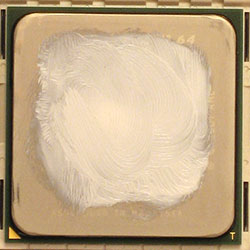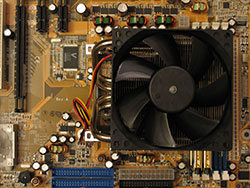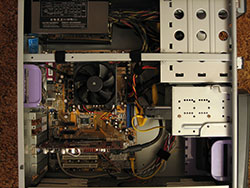Investigations into Socket 939 Athlon 64 Overclocking
by Jarred Walton on October 3, 2005 4:35 PM EST- Posted in
- CPUs
System Assembly
Once you have all the parts, it's time to put everything together. We're going to assume that you know the basic process, but here's our order for assembling a new system.
With the system up and running, install the OS and drivers. We use SATA drives almost exclusively for new PCs, which is why it's important to check the BIOS settings. Installing XP and the drivers is pretty simple, so we're not going to go into much detail. Use your CD and key, and then when XP is installed, you use the driver CD that comes with your motherboard. That will get you network, sound, and chipset drivers. You might want to check for newer versions online once you have networking installed, or else download them in advance on another PC and copy them to the new system. We also grab all the latest Windows Updates for any system with Internet access, though not necessarily for performance testing. Since we're only using one board, we installed all the Windows Updates along with a bunch of other software that we'll use in benchmarking. We also recommend switching your SATA hard drive to port 3 or 4 (or one of the extra ports) once Windows is installed. SATA ports 1 and 2 generally don't behave well when you begin overclocking beyond a certain threshold, and with the drivers installed, Windows should boot fine whether your primary drive is connected to port 1 or 3 or something else.
You'll note that up to this point, we haven't even talked about overclocking our new system. If you don't realize this already, let's make this clear: get your OS installed and running and test all your programs before you start overclocking! Setting up a new PC is a complex process, and even experienced system builders encounter problems. You don't want to have the Windows XP install program crash at 95% complete due to an overclock. It's not nearly as bad to have the system crash once you have it working, which is why we say to wait. Even then, it is possible to have an overclocked system crash and corrupt files, forcing you to reinstall applications or even XP from scratch. (It happened at least once in my testing, though not with socket 939.) There's a risk, but for many, the potential rewards outweigh the risk.
Once you have all the parts, it's time to put everything together. We're going to assume that you know the basic process, but here's our order for assembling a new system.
- Remove all components from boxes and lay them out on the workbench in an orderly fashion. (Check for order errors.)
- Install the CPU into the motherboard socket with the motherboard resting on the padded foam cushion with which it shipped.
- Apply a small amount of thermal paste to the center of the CPU heat spreader, then smooth it out a bit using your finger, a razor blade, etc. The idea is to get a thin layer on the heat sink, and you don't need to cover the whole CPU surface; once the HSF is installed, the thermal grease will flatten out to cover the rest of the CPU surface and you don't want a lot of extra grease. (Technically, AMD voids your CPU warranty if you don't use approved thermal grease. We've never had to deal with a failed Athlon 64 chip yet, so we can't comment on how they would respond. Overclocking is already voiding the warranty, so we're not worried about "approved" thermal compounds.)
- Install the heat sink onto the CPU - carefully. Depending on which HSF that you decide to purchase, you may need to change the mounting bracket, back plate, etc. One of the reasons why we like the Thermalright HSF is because you don't need to change the back plate (which is sometimes "glued" onto the motherboard). Don't forget to connect the fan to the 3-pin CPU header on the motherboard.
- Install the RAM into the appropriate slots. For the DFI board, that would be slots 3 and 4 (the two closest to the CPU). Other manufacturers number their slots differently and may separate the RAM for dual channel operation. Read the manual for your motherboard.
- If your case doesn't already have the power supply installed, it's generally best to install that now. Otherwise, the HSF for the CPU can get in the way. This varies by case, of course, but we almost always find it easier to get the PSU in before anything else.
- Install the motherboard mounts (usually little brass colored screws/bolts) into the case. Only put the mounts in places that match up to the holes on the motherboard. The DFI INFINITY has seven holes and thus requires seven mounts. You don't want extra mounts installed, as they could create a short on the bottom of the motherboard. Also, swap out your case's backplate for the one provided with your motherboard. (We have yet to encounter a case with a backplate that matches any motherboard that we've purchased.)
- Place the motherboard carefully into the case; you may have to work a little to get the backplate to line up with the rear I/O panel of the motherboard. Don't force anything. Once the board is in place, install the screws that secure the motherboard. Note that before installing the motherboard, depending on the case and your dexterity, it might be easier to connect the wires for the front panel of the case - power and HDD LEDs, reset and power switches, and speaker are almost always present. In our experience, the colored wires are usually the positive feed and the black (or white) wires are for ground. (I still get the LEDs backwards half the time, I think. If your HDD/Power lights don't come on, reverse the pins.)
- Install your graphics card, hard drive(s), DVD drive(s), cables, etc. We try to keep all the cables tidy, and you can use zip ties, velcro wraps, or even twisty ties if you don't mind a slightly ghetto approach. You might want to wait a minute before really securing all cables, just to be sure that all of the parts work properly. For now, plug the main SATA drive into SATA port 1. (If you're dead set on using RAID for your OS drive, you'll need a floppy disk with a driver on it.)
- Install any other fans or components, and make sure everything has power. Check the voltage switch on the rear of the PSU to make sure that it's set to 115V (or 230V depending on your location). Then plug in the power cord from the wall to the rear of your PSU, hold your breath, and turn on the system. Verify that all the fans are spinning.
- If the computer doesn't turn on, check that everything is seated properly and begin troubleshooting. Take it slow and don't jump to conclusions (i.e. "My RAM is bad!") Check the connections from the front panel of the case, as you might have simply installed the power switch cable incorrectly. Check all the other cables as well. If you have spare parts that you know work properly, try swapping them one at a time. Try running with just the CPU, graphics and RAM installed (no HDD or DVD). You might also want to remove the motherboard from the case and try powering on the system with the board sitting on the padded cushion (and anti-static bag) on your work area. If that works, check for anything in the case that might be grounding the board. You can try fully disassembling the PC and trying again, with the hope that perhaps you'll find your error in the process. Beyond that, you're on your own. Try the forums for help if you can't figure it out, but be patient and polite.
With the system up and running, install the OS and drivers. We use SATA drives almost exclusively for new PCs, which is why it's important to check the BIOS settings. Installing XP and the drivers is pretty simple, so we're not going to go into much detail. Use your CD and key, and then when XP is installed, you use the driver CD that comes with your motherboard. That will get you network, sound, and chipset drivers. You might want to check for newer versions online once you have networking installed, or else download them in advance on another PC and copy them to the new system. We also grab all the latest Windows Updates for any system with Internet access, though not necessarily for performance testing. Since we're only using one board, we installed all the Windows Updates along with a bunch of other software that we'll use in benchmarking. We also recommend switching your SATA hard drive to port 3 or 4 (or one of the extra ports) once Windows is installed. SATA ports 1 and 2 generally don't behave well when you begin overclocking beyond a certain threshold, and with the drivers installed, Windows should boot fine whether your primary drive is connected to port 1 or 3 or something else.
You'll note that up to this point, we haven't even talked about overclocking our new system. If you don't realize this already, let's make this clear: get your OS installed and running and test all your programs before you start overclocking! Setting up a new PC is a complex process, and even experienced system builders encounter problems. You don't want to have the Windows XP install program crash at 95% complete due to an overclock. It's not nearly as bad to have the system crash once you have it working, which is why we say to wait. Even then, it is possible to have an overclocked system crash and corrupt files, forcing you to reinstall applications or even XP from scratch. (It happened at least once in my testing, though not with socket 939.) There's a risk, but for many, the potential rewards outweigh the risk.













101 Comments
View All Comments
JarredWalton - Wednesday, October 5, 2005 - link
Sorry if I missed this in the article. The reason a 3200+ may be better is the 10X multiplier vs. 9X. Sure, the DFI board used worked pretty well at either setting, but there are many boards that won't handle much above 250 MHz CPU bus stably. Needless to say, there's a reason 2800 MHz was only included at one setting. While it still wasn't stable, it would actually run most benchmarks at 10x280. 9x311 wouldn't even load Windows half the time. The extra $50 for added flexibility is also nice: you can try 9x300, 10x270, PC3200, PC2700, etc. to find the most stable, highest performing option.Bakwetu - Wednesday, October 5, 2005 - link
Thanks for a great article. I haven't been following the development so carefully since I upgraded last time (with one of the last unlocked Barton 2500+), so this article was a most welcome refresher for me, as I will probably get a x2 3800 rig in the near future.Last time I checked using the naked fingertip to smear out the paste was a big no-no. I have always used either a washed razorblade or fingertip in a clean plastic bag. The Arctic silver once sold without silver was a faked, copied product as far as I know. The real stuff in its many forms over the years has definitely shown that it is a good product.
javalino - Wednesday, October 5, 2005 - link
Frist , great article, Jarred.Second, i m an anand fan since i remember (1999-2000).
Third, Since yours conclusion focus on a dilema about overclock, why spend to much in an overclock symtem(or on a powerfull system) if you target is at games ? (wich is a GPU limited). An 125 bucks , like you said, will be more usefull in a video card.
My idea is an article, about "Benefits, Costs, and Lessons Learned" about build a system for games. How much will be a performance gain from systems running high end cards ,at high resoltion and configurations ( like 1600 x 1200, and with an extra 4xAA 16XAF), with differents system . A FX VS 64(overclock) VS P4 (over) VS P-M VS AMD XP (over of course), for example. The conclusion will be, how much is "needed" to pay for a decent game machine wich is possible to play all current games(and maybe future) with great image quality and performance.
Maybe the answer is obvious, go with the best FPS/price option possible, or maybe not.
AtaStrumf - Tuesday, October 4, 2005 - link
Great article Jarred!!! I really like your choice of value parts and how you criticaly assesed the results based on the bang-for-the-buck. And finally you did away with pages and pages of bar charts, and combined them into line-scaling charts. How long have I been asking for something like that??? Now we can finally see the REAL difference (or lack of it), and analyse results properly, without having to go back and forth between tens of bar charts. Tell Anand to upgrade your graphing engine ASAP.I am a little worried about those voltages though. This sure looks like a bad chip to me (OC wise). WAY too high voltages. I would not go over 1,45 - 1,50 V or else you risk screwing up the chip. You see the memory controller on the chip doesn't like too high voltages and though it will still work, the chip will get slower eventually. Hard to explain really but I know my new 2,2 GHz A64 is faster and much cooler than my old 2,4 GHz A64 (same core - Newcastle, same cooer, same RPM, same case, same ...), which I bought from some crazy overclocker (last time BTW). The 2,4 GHz one gave me really shitty results in FAH for weeks. That's the only explanation a have so far anyway. Maybe you can do an investigaion into this -- burn in one A64 Venice at say 1,6V 24/7 for a few weeks and let's see what happens. I just don't have the $$$ and time to take the risk. I'd be very happy to hear from other forum members on this as well.
Anyway, glad to see at least part of AT is back to the high quality standards we were used to.
AtaStrumf - Tuesday, October 4, 2005 - link
Or maybe it's the SOI process that is to blame for not taking high voltages too kindly, or maybe both, don't know yet, but I would definitely advice caution goint over 1,5V (default for 0,13 mikron SOI chips). Just think about it, that's already a 15% increase. +10% is usualy max that is still considered safe.You just posted that this chip seems to have changed it's behavior (better OC). That may have something to do with the high voltages and it may not be all good. I'd suggest testing it again in a few benchmarks and comparing the results.
JarredWalton - Wednesday, October 5, 2005 - link
Working on it. I think I ended up benching at 1.850V for the 10x280 setting and then not dropping voltages as much as I was supposed to. I'm a little skeptical that a CPU would get slower, though. Usually, they work or they fail. We'll see.My thought on the "safe limit" though: what voltage does the FX-57 run at? Whatever it is, at 10 to 15% to that and you're probably still okay. Good cooling will also help; on the stock HSF, I'd be a lot more nervous going over 1.550V.
OvErHeAtInG - Tuesday, October 4, 2005 - link
Very useful article - thorough yet concise. And I would like to toss in another request: Add to the test a ULi-based motherboard (such as the recently reviewed ASRock 939Dual-SATA2). How do these Venices overclock when you can only feed them +.05v? As I recall the standard AT Clawhammer was used in that review.That would be hugely useful to a lot of us wanting to transition to A64. While the thing to do is probably just get a DFI or other top-end oc'er, what to do for those of us who are not yet ready to upgrade GPUs? On second thought: you could simulate the ASRock motherboard by simply setting the Venices to the lower voltage, on the DFI board, and testing for the max overclock on that. I think that would vary quite a bit from chip to chip, but just to get an idea - how much of a disadvantage is being limited in your voltage? Food for thought.
JarredWalton - Tuesday, October 4, 2005 - link
I played around with voltages a bit more last night. It seems like I can hit about 2.40 GHz with only increasing the CPU voltage to 1.40V, though I didn't run all of the benchmarks to fully test that config. I'm not sure if the CPU has changed behavior over the past month, or if I was just too liberal with the voltages initially.For the ASRock, that Wes managed to get a 500 MHz OC even with the minimal voltage adjustments is promising. Truth be told, the DFI Infinity seems to undervolt the CPU slightly, so 1.500V actually shows up as closer to 1.455V. If the ASRock is exact with the voltages, or even a bit high, I think a 2.4+ GHz overclock is a reasonably safe bet.
OvErHeAtInG - Wednesday, October 5, 2005 - link
Thanks for the info, Jarred. I'm sure there's a thread on this somewhere.... :)araczynski - Tuesday, October 4, 2005 - link
i haven't seen a better argument for not wasting money on the 'better' memory in ages.with those kinds of 'gains' i congratulate the companies for milking everyone with their markups for the 'higher end' components.